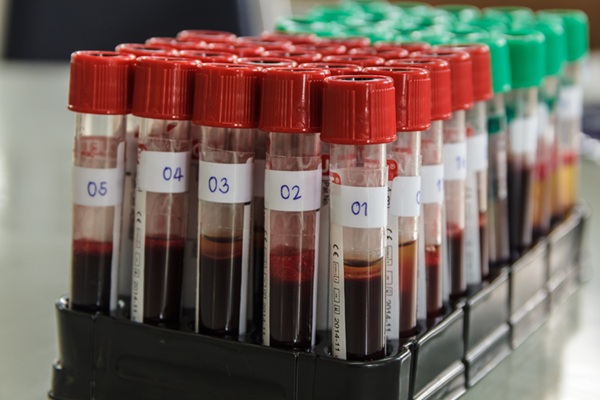Enhanced S100B Expression in Lymphocytes in Spontaneous Preterm Birth and Preeclampsia
|
By LabMedica International staff writers Posted on 16 Nov 2021 |

Image: Scanning electron micrograph of a CD4+ T cell – these cells expresses elevated levels of S100B in PE/HELLP patients (Photo courtesy the British Society of Immunology)
Preterm birth is commonly defined as any birth before 37 weeks completed weeks of gestation. An estimated 15 million infants are born preterm globally, disproportionately affecting low and middle income countries.
S100B is a calcium-binding peptide and is used as a parameter of glial activation and/or death in many disorders of the central nervous system (CNS). It plays important roles in normal CNS development and recovery after injury. Although S100B is mainly found in astroglial and Schwann cells, it also has extracerebral sources.
A team of Clinical Scientists led by those at the University of Leipzig (Leipzig, Germany) and in collaboration with the Otto von Guericke University (Magdeburg, Germany) determined the concentration of S100B in maternal and cord blood (CB) plasma and placenta supernatant as well as the expression of S100B in maternal and CB CD4+ T cells and CD19+ B cells in Spontaneous Preterm Birth (sPTB) and patients delivering following preeclampsia (PE) and HELLP (hemolysis, elevated liver enzymes, and low platelet count). (PE/HELLP) diagnosis was compared to women delivering at term (TD). The S100B expression was further related to the birth weight in the study cohort.
The investigators reported that S100B concentration was enhanced in maternal and CB plasma of sPTB and PE/HELLP patients and positively correlated with interleukin-6 (IL-6) levels. Increased S100B was also confirmed in CB of small-for-gestational-age (SGA) infants. S100B expression in maternal blood was elevated in CD4+ T cells of PE/HELLP patients and patients who gave birth to SGA newborns as well as in CD19+ B cells of sPTB and PE/HELLP patients and patients with SGA babies. In CB, the expression of S100B was increased in CD19+ B cells of sPTB, PE/HELLP and SGA babies.
The authors concluded that their results support the hypothesis that S100B expression is enhanced in inflammatory events associated with preterm birth and that S100B expression in immune cells is a relevant marker for inflammation during pregnancy complications. The study was published on November 1, 2021 in the Journal of Perinatal Medicine.
Related Links:
University of Leipzig
Otto von Guericke University
S100B is a calcium-binding peptide and is used as a parameter of glial activation and/or death in many disorders of the central nervous system (CNS). It plays important roles in normal CNS development and recovery after injury. Although S100B is mainly found in astroglial and Schwann cells, it also has extracerebral sources.
A team of Clinical Scientists led by those at the University of Leipzig (Leipzig, Germany) and in collaboration with the Otto von Guericke University (Magdeburg, Germany) determined the concentration of S100B in maternal and cord blood (CB) plasma and placenta supernatant as well as the expression of S100B in maternal and CB CD4+ T cells and CD19+ B cells in Spontaneous Preterm Birth (sPTB) and patients delivering following preeclampsia (PE) and HELLP (hemolysis, elevated liver enzymes, and low platelet count). (PE/HELLP) diagnosis was compared to women delivering at term (TD). The S100B expression was further related to the birth weight in the study cohort.
The investigators reported that S100B concentration was enhanced in maternal and CB plasma of sPTB and PE/HELLP patients and positively correlated with interleukin-6 (IL-6) levels. Increased S100B was also confirmed in CB of small-for-gestational-age (SGA) infants. S100B expression in maternal blood was elevated in CD4+ T cells of PE/HELLP patients and patients who gave birth to SGA newborns as well as in CD19+ B cells of sPTB and PE/HELLP patients and patients with SGA babies. In CB, the expression of S100B was increased in CD19+ B cells of sPTB, PE/HELLP and SGA babies.
The authors concluded that their results support the hypothesis that S100B expression is enhanced in inflammatory events associated with preterm birth and that S100B expression in immune cells is a relevant marker for inflammation during pregnancy complications. The study was published on November 1, 2021 in the Journal of Perinatal Medicine.
Related Links:
University of Leipzig
Otto von Guericke University
Latest Immunology News
- Chip Captures Cancer Cells from Blood to Help Select Right Breast Cancer Treatment
- Blood-Based Liquid Biopsy Model Analyzes Immunotherapy Effectiveness
- Signature Genes Predict T-Cell Expansion in Cancer Immunotherapy
- Molecular Microscope Diagnostic System Assesses Lung Transplant Rejection
- Blood Test Tracks Treatment Resistance in High-Grade Serous Ovarian Cancer
- Luminescent Probe Measures Immune Cell Activity in Real Time
- Blood-Based Immune Cell Signatures Could Guide Treatment Decisions for Critically Ill Patients
- Novel Tool Predicts Most Effective Multiple Sclerosis Medication for Patients
- Companion Diagnostic Test for CRC Patients Identifies Eligible Treatment Population
- Novel Tool Uses Deep Learning for Precision Cancer Therapy
- Companion Diagnostic Test Identifies HER2-Ultralow Breast Cancer and Biliary Tract Cancer Patients
- Novel Multiplex Assay Supports Diagnosis of Autoimmune Vasculitis
- Blood Test Predicts Immunotherapy Efficacy in Triple-Negative Breast Cancer
- Simple Genetic Testing Could Predict Treatment Success in Multiple Sclerosis Patients
- Novel Gene Signature Predicts Immunotherapy Response in Advanced Kidney Cancers
- New Technology Deciphers Immune Cell Communication to Predict Immunotherapy Response
Channels
Clinical Chemistry
view channel
VOCs Show Promise for Early Multi-Cancer Detection
Early cancer detection is critical to improving survival rates, but most current screening methods focus on individual cancer types and often involve invasive procedures. This makes it difficult to identify... Read more
Portable Raman Spectroscopy Offers Cost-Effective Kidney Disease Diagnosis at POC
Kidney disease is typically diagnosed through blood or urine tests, often when patients present with symptoms such as blood in urine, shortness of breath, or weight loss. While these tests are common,... Read moreMolecular Diagnostics
view channel
New Biomarker Panel to Improve Heart Failure Diagnosis in Women
Heart failure affects millions worldwide, yet many women are still misdiagnosed or diagnosed too late. Although heart failure broadly means the heart cannot pump enough blood to the body’s cells, its two... Read more
Dual Blood Biomarkers Improve ALS Diagnostic Accuracy
Diagnosing amyotrophic lateral sclerosis (ALS) remains difficult even with advanced imaging and genetic tools, especially when clinicians must distinguish it from other neurodegenerative conditions that... Read moreHematology
view channel
ADLM’s New Coagulation Testing Guidance to Improve Care for Patients on Blood Thinners
Direct oral anticoagulants (DOACs) are one of the most common types of blood thinners. Patients take them to prevent a host of complications that could arise from blood clotting, including stroke, deep... Read more
Viscoelastic Testing Could Improve Treatment of Maternal Hemorrhage
Postpartum hemorrhage, severe bleeding after childbirth, remains one of the leading causes of maternal mortality worldwide, yet many of these deaths are preventable. Standard care can be hindered by delays... Read more
Pioneering Model Measures Radiation Exposure in Blood for Precise Cancer Treatments
Scientists have long focused on protecting organs near tumors during radiotherapy, but blood — a vital, circulating tissue — has largely been excluded from dose calculations. Each blood cell passing through... Read moreMicrobiology
view channel
15-Minute Blood Test Diagnoses Life-Threatening Infections in Children
Distinguishing minor childhood illnesses from potentially life-threatening infections such as sepsis or meningitis remains a major challenge in emergency care. Traditional tests can take hours, leaving... Read more
High-Throughput Enteric Panels Detect Multiple GI Bacterial Infections from Single Stool Swab Sample
Gastrointestinal (GI) infections are among the most common causes of illness worldwide, leading to over 1.7 million deaths annually and placing a heavy burden on healthcare systems. Conventional diagnostic... Read morePathology
view channel
AI Tool Improves Accuracy of Skin Cancer Detection
Diagnosing melanoma accurately in people with darker skin remains a longstanding challenge. Many existing artificial intelligence (AI) tools detect skin cancer more reliably in lighter skin tones, often... Read more
Highly Sensitive Imaging Technique Detects Myelin Damage
Damage to myelin—the insulating layer that helps brain cells function efficiently—is a hallmark of many neurodegenerative diseases, age-related decline, and traumatic injuries. However, studying this damage... Read moreTechnology
view channel
AI Model Achieves Breakthrough Accuracy in Ovarian Cancer Detection
Early diagnosis of ovarian cancer remains one of the toughest challenges in women’s health. Traditional tools such as the Risk of Ovarian Malignancy Algorithm (ROMA) can struggle to distinguish between... Read more
Portable Biosensor Diagnoses Psychiatric Disorders Using Saliva Samples
Early diagnosis of psychiatric disorders such as depression, schizophrenia, and bipolar disorder remains one of medicine’s most pressing challenges. Current diagnostic methods rely heavily on clinical... Read more
Cell-Sorting Device Uses Electromagnetic Levitation to Precisely Direct Cell Movement
Sorting different cell types—such as cancerous versus healthy or live versus dead cells—is a critical task in biology and medicine. However, conventional methods often require labeling, chemical exposure,... Read moreIndustry
view channel
Co-Diagnostics Forms New Business Unit to Develop AI-Powered Diagnostics
Co-Diagnostics, Inc. (Salt Lake City, UT, USA) has formed a new artificial intelligence (AI) business unit to integrate the company's existing and planned AI applications into its Co-Dx Primer Ai platform.... Read more























